Research Achievement
2020
본 연구단의 단장그룹의 이차원물질연구는 주로 상호작용이 강한 이차원물질을 인위적으로 조절 조작하여 새로운 물성을 발현하는 것에 집중하고 있다. 본 연구에서는 상호작용이 강한 이차원물질 IrTe2을 활용하여 새로운 성질을 가지는 인위적인 원자단위구조를 형성하려 시도하였다. 특히 IrTe2의 경우는 Ir d 전자의 전하질서 상전이를 통해 저온에서 stripe 구조를 가지게 됨이 알려져 있었고, 본 연구단에서는 이에 추가적으로 벌집구조를 가지는 새로운 저온상을 발견한 바 있다. 본 연구에서는 벌집구조의 전하질서상에 상대론적 효과가 매우 큰 Pb 원자를 증착하여 본 물질에서의 상대론적 물성을 증폭시키려는 시도를 하였다. 이 시도의 결과 Pb 원자들이 벌집구조에 갇혀 다양하지만 질서있는 클러스터 구조를 형성함을 발견하였다. 또한 이러한 클러스터 구조에서 분자결합 orbital 들을 실험적으로 발견하였다. 이론적 연구결과 이러한 분자결합 orbital들은 강한 상대론적 효과가 지배하고 있어, 발견된 클러스터들은 이전의 금속클러스터들과는 완전히 다른 상대론적 분자를 형성하고 있음을 보고하였다. 본 연구는 상호작용 강한 이차원물질이 가지는 새로운 물질상이 더욱 새로운 인공적인 물질을 합성하는 기반이 될 수 있음을 보여주는 중요한 연구라 할 수 있다.
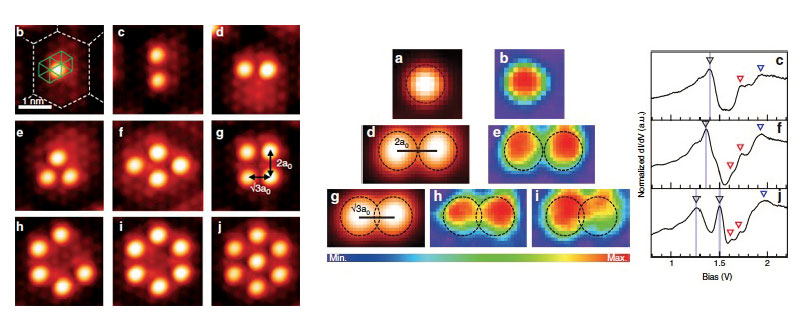
Figure 2. Artificial molecules with strong spin-orbit coupling as formed on the honeycomb charge order superlattice of IrTe2 (Nature Communications 2020).
One of our major proposals to possibly produce new quantum phases and functionalities is utilizing the proximity interactions at interfaces of heterostructures of 1D/2D materials. In particular, we have focussed on 2D materials with strong interactions such as electron correlation, electron-phonon interaction, or excitonic interactions, to access emerging quantum phases easily. In the present work, we continued our research activity to put monolayer or submonolayer metals on strongly interacting 2D materials. Pb was chosen for its strong tendency toward superconductivity and stong spin-orbit interaction. On the surface of IrTe2, we discovered honeycomb charge orderings and the formation of a plethora of Pb clusters within the honeycomb unitcells. These clusters, including the benzene ring of Pb shown below, form molecular orbitals, which is governed by the strong spin-orbint interaction. That is, these clusters are the very rare realization of molecules in the strong spin-orbit interaction regime, which are called ‘Dirac molecules’ (Nature Communicatioins 2020).
전기가 통하도록 설계 ∙ 합성한 2차원 물질은 유연하고 투명하면서도 기존 3차원 물질과 전혀 다른 물리적 성질을 보여, 차세대 전자 소자의 소재로 연구되고 있다. 특히 2차원 물질은 스핀 정보의 생성 ∙ 전달 ∙ 조절을 할 수 있는 핵심 소재로 꼽히는데, 이 중 스핀 정보‘생성’에 필요한 강자성을 띠는 2차원 물질은 매우 드문데다, 대부분 전기가 흐르지 않거나 극저온에서만 자성이 발현돼 응용성이 적었다. 2차원 물질만으로 이뤄진 스핀소자를 구현하기 위해서는 상온에서 강자성을 띠는 2차원 물질에 대한 탐색이 필요하였다.
본 연구에서는 상온에서 자성을 띠는 Fe4GeTe2을 설계 ∙ 합성하고, 이를 한 층 떼어내 2차원 자석을 만들어 보고하였다. 물질설계를 위해 11,000개에 이르는 다양한 철 기반 후보물질의 안정성과 자성을 전자구조 계산으로 예측한 후, 체계적인 소재 합성을 통해 예측한 물질 중 Fe4GeTe2를 합성하는 데 성공하였다. 개발된 Fe4GeTe2는 강자성을 나타내는 온도가 상온근처로 기존 2차원 자석에 비해 매우 높고, 수 나노미터 두께의 한 층으로 떼어냈을 때도 강자성이 그대로 유지되는 성질이 발현되었다. 또한 두께가 얇아짐에 따라 수직 자기 이방성이 커지는 현상이 관측되었다. 이는 스핀 메모리소자 구현에 필요한 높은 상전이 온도, 높은 수직 자기이방성을 2차원 강자성체를 이용해 구현할 수 있는 가능성을 시사한다.
이번 성과는 2차원 자성체를 설계한 최초의 사례인데다, 전기전도성까지 부여하는 데 성공해 향후 차세대 스핀 소자 스핀정보소자에 활용이 기대된다. 또한 다른 2차원 물질과 쉽게 결합할 수 있다는 장점도 있어 향후 서로 다른 2차원 물질을 접합해 만들어질 스핀정보소자 연구에 활용이 기대된다.
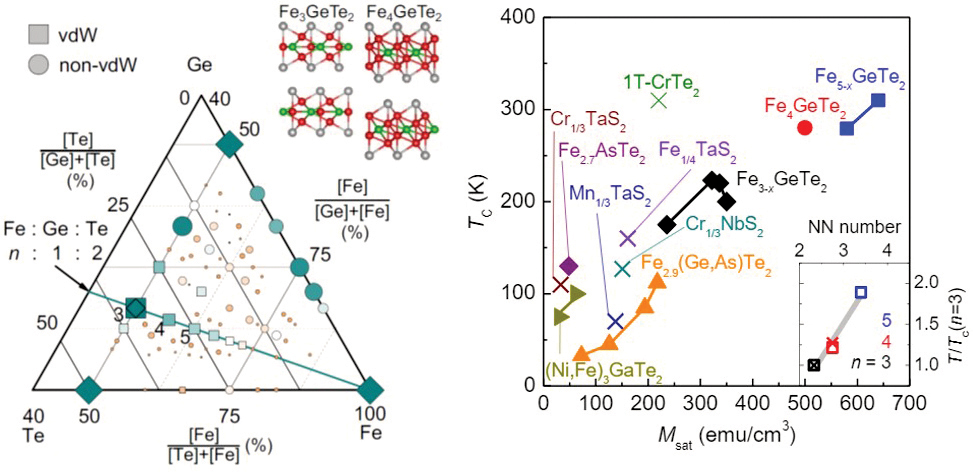
Figure 1. (left) Computational material design for FenGeTe2 (right) Tc and magnetization for various ferromagnetic vdW materials.
The isolation of various two-dimensional (2D) materials has triggered intensive theoretical and experimental studies on exploring new phenomena and designing novel devices with tailored functionalities in the 2D limit. Particularly in spintronics, 2D materials can surpass many known 3D materials in spin-related functionalities. Despite recent developments, most of the van der Waals (vdW) ferromagnets have relatively low critical temperatures, well below the room temperature. If a stable vdW ferromagnet exist at room temperature, it can be used as a key component in all-vdW-material based spintronic applications.
In this study, we take a new approach to achieve high Tc in vdW ferromagnets, designing a material having a 3D-like network of magnetic elements with enhanced exchange interaction within the vdW structure. To realize this material design scheme, we propose FenGeTe2 (n ≥ 3) as a model system, and using ab initio calculations identified the stable FenGeTe2 compounds, consisting of Fe-rich thick slabs stacked by vdW coupling. We successfully synthesize a newly designed vdW material Fe4GeTe2 that exhibits room temperature ferromagnetism with Tc = 270 K and has a large conductivity, a large magnetic moment, and a low magnetic anisotropy. Furthermore, with reducing thickness, Tc‘s of Fe4GeTe2 nanoflakes are maintained while the perpendicular magnetic anisotropy is enhanced, leading to a hard magnet type hysteresis. These results clearly demonstrate synergetic combination of material design and thickness control on vdW magnets, which improves the magnetic properties more suitable for realistic spintronic applications.
원자층 반도체에서 고유의 빛-격자 반응을 통해 빛의 파장에 따른 선택적인 점결함을 유도할 수 있음을 발견하였으며, 이를 이용해 원자층 반도체 채널의 국소 영역 도핑을 자유로이 제어하는 “광유도 도핑” 공정을 개발하였다. 반도체 단일 집적 소자는 n-형 또는 p-형으로 선택적 도핑이 자유로이 이루어져야 하는데, 신물질로서 이차원 반데르발스 반도체에서는 이와 같은 도핑 공정이 그동안 부재하였다. 본 연구에서는 빛의 파장과 세기에 따른 상이한 광화학 반응이 유도되어 n-형 또는 p-형 원자 점결함이 발생됨을 주사터널현미경과 투과전자현미경 분석을 통해 원자 수준에서 규명하였다. 특히 이러한 점결함 형성은 가역적이여서, 동일 반도체 채널을 n-형 또는 p-형 채널로 실시간 변조 가능하다. 이러한 가역적 도핑은 기존 반도체에서 구현되지 않은 새로운 현상이다. 본 연구진은 이러한 현상을 이용하여 빛을 이용해 자유자재로 그 기능을 바꿀 수 있는 집적회로 소자를 구현하였다. 대표 예시로 이차원 반데르발스 반도체 기반의 상보성 금속 산화막 반도체 (CMOS) 인버터에 다른 파장의 빛을 가함으로써 이를 전혀 반대의 기능을 갖는 CMOS 스위치로 뒤바꿀 수 있음을 보였다.

Figure 3. Reconfigurable 2D vdW integrated circuitry with light colors. (a) Schematic of light-lattice interactions in 2D materials. (b) Selective generation of active electron and hole dopants in 2D host lattices by choice of light wavelength. Individual electronic structures were probed by STM/S. (c) Schematic of reconfigurable 2D vdW integrated circuitry with light colors. (Nature Electronics, 4, 38-44, 2021)
We report the reversible photo-induced doping of atomically thin van der walls semiconductors, where the channel polarity can be reconfigured from n-type to p-type, and vice versa, with laser light at different frequencies. Unlike conventional silicon semiconductors, simple doping methods to monolithically assemble n-and p-type channels on a single two-dimensional semiconductor are lacking, which makes the fabrication of integrated circuitry challenging. This reconfigurable doping in this work is attributed to selective light-lattice interactions, such as the formation of self-interstitial point defects under ultraviolet illumination and the incorporation of substitutional oxygen to vacancies under visible illumination. Using this approach, we create a complementary metal-oxide-semiconductor (CMOS) device on a single channel, where the circuit functions can be dynamically reset from a CMOS inverter to a CMOS switch using pulses of different light frequencies.
본 연구단의 단장그룹의 이차원물질연구는 주로 상호작용이 강한 이차원물질을 인위적으로 조절 조작하여 새로운 물성을 발현하는 것에 집중하고 있다. 본 연구에서는 상호작용이 강한 이차원물질 NbSe2에서 결함구조를 활용하여 물성을 조절하는 가능성을 탐구하였다. 전년도의 연구에서 본 연구단은 NbSe2의 전하밀도파상이 서로 다른 두가지 전하밀도파 구조가 섞여있음을 세계최초로 발견하였다. 본 연구에서는 이 물질이 주로 3가지의 결함구조를 가짐을 밝혔고, 상전이의 과정에서 이들 결함이 서로 다른 두가지 전하밀도파를 선택적으로 유도함을 발견하였다. 또한 이러한 결함과 전하밀도파의 선택적 상호작용이 서로 다른 결함구조가 제공하는 국소적인 격자변화가 다름에 기인함을 이론적으로 제시하였다. 이는 오랫동안 연구된 전하밀도파와 결함의 상호작용에 대한 물리에 완전히 새로운 측면을 제시하는 발견으로서 향우 많은 전하밀도파 물질의 연구에서 고려되어야 할 중요한 물성의 발견이라 평가된다.
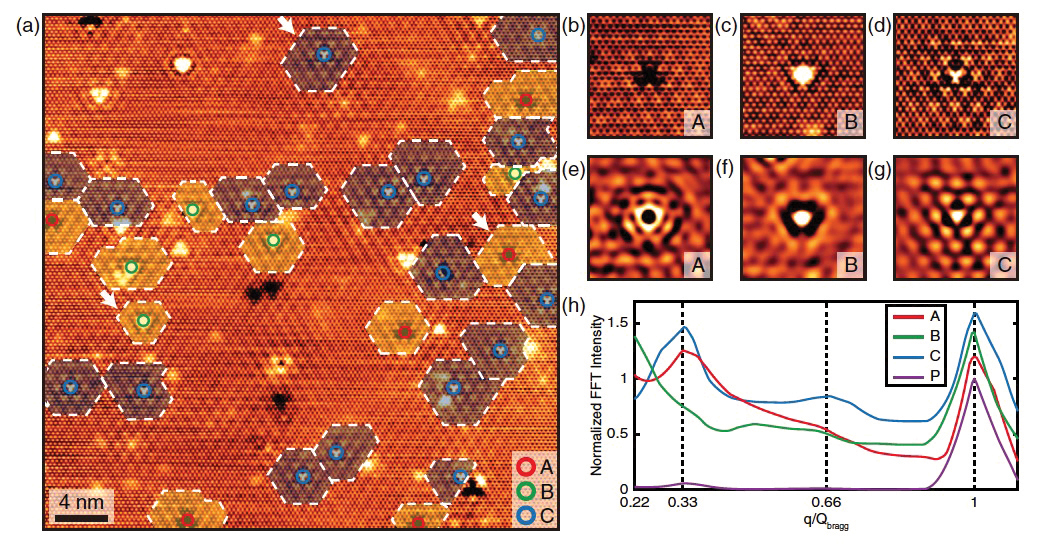
Figure 4. STM images of the native defects of NbSe2 and the locally induced CDW structures above the transition temperature.
Defects have been known to substantially affect quantum states of materials including charge density wave (CDW). However, the microscopic mechanism of the influence of defects is often elusive due partly to the lack of atomic scale characterization of defects themselves. We investigate native defects of a prototypical CDW material 2H-NbSe2 and their microscopic interaction with CDW. Three prevailing types of atomic scale defects are classified by scanning tunneling microscope (STM) and their atomic structures are identified by density functional theory (DFT) calculations as Se vacancies and Nb intercalants. Above the transition temperature, two distinct CDW structures are found to be induced selectively by different types of defects. This intriguing phenomenon is explained by competing CDW ground states and local lattice strain fields induced by defects, providing a clear microscopic mechanism of the defect-CDW interaction.
본 연구단의 단장그룹의 이차원물질연구는 주로 상호작용이 강한 이차원물질을 인위적으로 조절 조작하여 새로운 물성을 발현하는 것에 집중하고 있다. 본 연구에서는 상호작용이 강한 이차원물질 TaS2가 가지는 저온에서의 모트절연체상을 단원자층 레벨의 흡착원자층을 활용하여 새로운 물질상으로 변화시키려는 시도를 하였다. 본 연구에서는 특히 알칼리금속(K)을 표면층 격자 단위셀의 1/3에 균일하게 흡착시킨 인위적인 이차원 구조를 형성하는데 성공하였다. 이러한 구조에서는 알칼리원자가 흡착된 단위셀들이 삼각격자구조를 가지는 일반적인 밴드절연체 격자를 형성하게 되는 반면, 나머지 흡착되지 않은 2/3의 단위셀들은 벌집격자구조를 가지면서 모트 절연체적인 전자를 유지하게 된다. 이러한 벌집격자구조를 가지는 모트 절연체는 벌집격자구조에서 유래하는 위상학적 성질과 강한 전자상호작용에 기인한 모트 절연체적인 성질을 동시에 가지는, 소위 Kane-Mele-Hubbard Hamiltonian에 의해 기술되는, 전자계로서 아직까지 물질에서 제대로 구현된 적인 없는 새로운 전자계에 해당된다. 본 연구에서는 실험적으로 이러한 계를 구현하였으며 전자구조계산과 이론연구를 통하여 이러한 계의 새로운 물성을 뒷받침하였다. 이를 넘어서, 본 연구는 이차원 물질과 흡착원자의 결합을 통해 다양한 새로운 물성을 가지는 인위적인 물질계를 만들 수 있다는 새로운 가능성과 분야를 여는 성과라 평가할 수 있다.

Figure 5. Hexagonal lattice of K adatoms on TaS2 leaves Ta dz electrons in a honeycomb lattice, which represents a material realization of a honeycomb lattice Mott insulator (Phys. Rev. Lett. 2020).
We successfully fabricated an ordered superstructures of akali metal adsorbates 1T-TaS2, which leave 2/3 of surface unitcells in a honeycomb lattice. On its Mott insulating phase, this lattice represents a honeycomb Mott insulator with active topological degrees of freedom (Phys. Rev. Lett. 2020). This is one of the first material realization of the Kane-Mele-Hubbard Hamiltonian and provides an extremely interesting platform to seek novel emerging phases as discussed in twisted bilayer graphene.
격자와 전자들의 열적 반응은 피코초 이하의 빠른 시간 내에 이루어지기 때문에 pump-probe ARPES와 같이 동적 현상을 관측하기 위해 특별히 구축된 장치를 사용해야만 한다. 그러나, 중시 크기의 초격자(superlattice)들은 이보다 훨씬 느리게 반응하는 경우가 많아서 재빠른 가열, 냉각 과정을 통해 준평형 상태를 만들 수 있고, 이 상태에서 새로운 물성이 발견되는 경우가 많다. 그 대표적인 예가 1T- TaS2 인데, 온도에 따라 여러 번의 전하밀도파 전이 현상을 보이며, 빠른 속도로 가열, 냉각할 경우, 소위 숨겨진 상태(hidden phase)에 이를 수 있다는 것이 잘 알려져 있다. 이 상태들은 주로 엑스선 회절 또는 전기적, 광학적 성질의 변화로 검증되어 왔으나, 이러한 물성변화의 원인이 되는 전자구조에 대한 연구는 실험의 난점으로 거의 이루어진 바가 없다. 본 연구단은 초고진공 환경에서 빠른 속도로 가열, 냉각하는 장치를 개발하고, 이를 포항가속기에 본 연구단이 구축한 ARPES 빔라인에 설치하여 숨겨진 상태에 대한 전자구조를 성공적으로 측정하였다. 실제 ARPES 측정이 이루어지는 시료 표면의 일부만을 가열하여 특정 온도를 유지하는데 필요한 열량을 최소화하였고, 이를 통해 급속 냉각도 가능하도록 하였다. 또한, 전 과정을 ARPES로 실시간 관측함으로써 상변화를 추적할 수 있도록 하였다. 위 그림에 나타낸 ARPES 스펙트럼들은 모두 100 K에서의 전자구조를 측정한 것인데, 고온의 격자구조를 저온에서도 그대로 유지하여 숨겨진 상태에 대한 ARPES를 얻었다는 것을 확인할 수 있다.
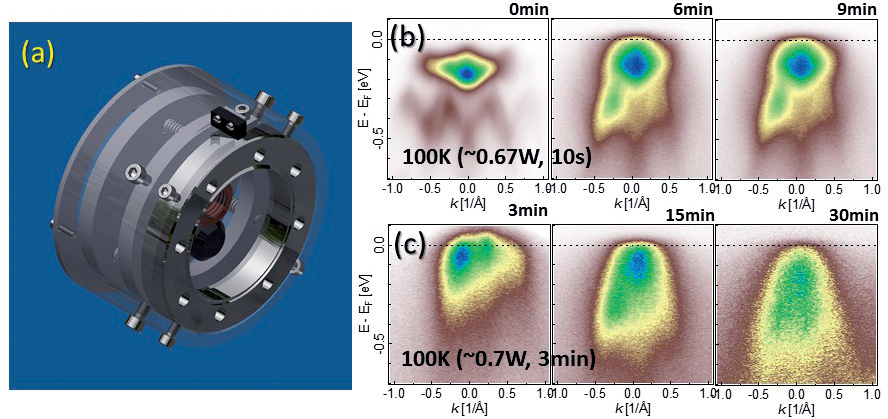
Figure 6. (a) The kinematic mount of IR laser optics and CCD. (b) ARPES spectra on quenched states of 1T-TaS2. (c) Unquenched spectra by a higher irradiation dose are compared.
The thermal responses of lattices and electrons are far faster than pico-seconds and only dedicated pump-probe ARPES systems can investigate the dynamic phenomena in such a time scale. However, a few lattice systems, especially the superlattices with mesoscopic length scale have very slow time constants with a notable example of our own interest, a series of metastable hidden phases in 1T-TaS2. In order to access the metastable phases with our ARPES system, a designated heating scheme was developed with minimum heat transfer and fast heat dissipation by combining a focused IR laser with a cryostat. By heating only the surface area and subsequent cooling from the bottom of the thin single crystal flake of TaS2, as shown in the figure above, we successfully obtained a series of ARPES spectra of low temperature electrons with the lattice of high temperatures. During the overall thermal process, we monitor the phases by capturing ARPES spectra of high symmetric direction continuously. This system can be applied various 2D materials to probe the thermally excited or quenched phases
본 연구단의 밀리 켈빈 고자기장 ( ~ 10 테슬라) 주사 터널 현미경은 조립 및 각종 테스트 완료되어, 조만간 이 장비의 최대 성능 시연을 앞두고 있다. 작년 냉동기 안의 인서트에서 초고진공 맄이 발견되어, 이를 고치기 위해 실버 솔더링 등의 많은 노력이 필요했었다. 제작사가 소재하는 지역의 보건 상항이 악화되어 연구자들이 직접 이 문제를 해결하였다. 또한 이 장비의 핵심 요소인 STM 스캐너를 향상시켰다. 우선 스캐너를 소형화 (외경 20 밀리미터) 및 모듈화 시켜서, 쉽게 다른 스캐너 모듈로 교체가 쉽게 만들었으며, 여러 개의 링 형태의 압전 물질층을 이용한 새로운 타입의 z 모터를 개발하여 사용 중이다. 대략 1/8 인치 정도의 외경을 가지면서, 모터의 축을 밀어내고 끌어 당기는 힘을 수 뉴턴까지 증강 시켰다. 밀리켈빈 온도 대역에서 자기장을 변화시킬 때 발생하는 와상 전류 발열을 최소화 시키기 위해서, 금속 재질의 사용을 최소화 하고 주로 세라믹 물질을 사용하였다 (그림 1). 이 STM 스캐너를 냉동기안의 초전도 자석 중심에 부착하는, 스캐너 매니퓰레이터의 성능도 향상 시켰다.
본 장비는 가능한 많은 주사 터널 현미경 연구 영역을 쉽게 접근 할 수 있도록 설계되어 있다. 기판의 물성을 주로 연구하는 분야 뿐만 아니라, 특히 단일 원자나 분자들로 이루어진 단일 스핀 센터의 연구에 집중 할 수 있게 본 장비를 갖추었다. 조만간 최대 성능 테스트를 위해서, 초전도 물질의 BCS 갭을 측정하는 방법과 단일 전자 스핀 센터에서 발현 되는 스핀 플립 비탄성 전자 터널 분광 기법을 이용하려 한다. 더 나아가, 이 장비의 최대 성능을 보여주기 위한 실험으로, 단일 전자 스핀과 주변 원자의 핵스핀과의 초미세 상호작용을 측정하여, 단일 전자 스핀에 가해지는 핵스핀의 효과도 측정하려 한다. 이러한 실험을 위해서, 금속 기판에 수 옹스트롱 두께의 산화막위에 증착된 여러 종류의 포핀(porphin) 분자들을 이용하려 한다.
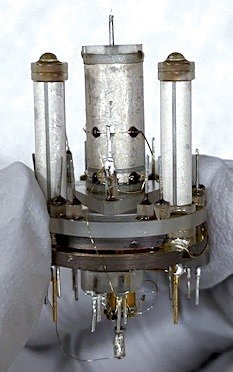
Figure 7. Scanner module for milli-Kelvin high magnetic field scanning tunneling microscope
Our center’s STM capable of studying matter at milli-Kelvin and high magnetic field (up to ~10 Tesla) is at its final stage of test operations, and is expected to show its full performance soon. Last year, we found an ultrahigh vacuum leak in our cryostat inert, and did a lot of efforts to fix it., Our STM scanner has been improved for the last year. We adopted a new modular design for easy STM scanner replacement (Figure 1) and developed a small-sized (~ 1/8 inch in outer diameter) coarse z motor based on piezoelectric stacks capable of strong push/pull force (~ several Newtons). The scanner module is made out of ceramics mostly for least eddy current heating during magnetic field sweeping, and use metallic components as little as possible. Also, the scanner manipulator, which is used for attaching/detaching the scanner to/from the center of the superconducting magnet in the cryostat, has been improved, especially the cooling speed for cooling down the scanner to low temperature.
We designed this STM system in such a way that it can cover as many research areas as possible, especially study of single spin centers made out of single atoms and molecules, as well as study of novel substrates mainly. In order to show this microscope’s full performance, we will carry out electron temperature measurements using a superconducting substrate and single spin-flip inelastic electron tunneling spectroscopy. Furthermore, in order to demonstrate its unprecedented energy resolution, we are planning an experiment accessing effects of nuclear spins on electron spins through the hyperfine interaction using a molecule charged permanently by single electron such as a few kinds of porphins on several-angstrom thick decoupling oxide layer on metallic substrate.
극저온고자기장 주사탐침 현미경(ULT HF SPM)은 극저온(2 K), 자기장 (12 T)의 극한 환경 에서 원자 수준의 분해능으로 고체 표면 상태를 탐색 할 수 있다. 이로써 본 연구단은 기존 보유한 주사터널링 현미경 (STM)의 자기장 인가 한계를 12T 까지 확장했을 뿐 아니라, 원자힘 현미경 (Atomic Force Microscopy: AFM) 과 주사 터널링 현미경 (Scanning Tunneling Microscopy : STM)의 두가지 방식으로 동작가능하는 ULT-HF-SPM을 통해서 금속 뿐만 아니라 절연체 표면에 대해서도 원자 수준의 분해능으로 연구할 수 있다.
지난 2020년 우리는 극저온 환경을 유지하는 냉동기의 단열 문제를 해결하고, 핵심 부품인 SPM Head를 보완 하였다. 이어서, 극저온환경 (2-4K)에서 장비의 성능을 확인하였다. 극저온 상태를 위한 단열 성능(LHe consumption rate ~ 0.25/hr), 고자기장 (12 T) 인가, tuning fork probe 를 이용한 AFM & STM mode 원자 분해능, 극저온하에서 에너지 분해능 (superconducting gap of Pb islands/Si(111)) 등 을 확인하였다.
ULT-HF-SPM 은 시료의 표면 상태를 조절하기 위하여 열처리, 증착, 저온 벽개, 표면 분석, 등의 저차원 물질 연구를 위해 다양한 표면 처리 기법들을 함께 갖추고 있다. 또한, 저차원 물질의 표면 cleanliness를 확보하기 위하여 새로운 방식(overturn cleaving) 도입하였다. 이후 재료 물리 그룹에서 기상증착(CVD) 방식으로 성장한 다양한 저차원 이종접합구조 연구를 위하여 UHL-HF-SPM을 활용할 것이다.

Figure 8. (a) ULT-HF-SPM (inset) tuning fork with W tip. (b, c) AFM image of (b) Si(111) and (c) Pb(111) (d) Pb superconducting gap in tunneling spectroscopy.
We have constructed an ultra-low temperature high-field scanning probe microscope (ULT-HF-SPM), exploring low-dimensional systems in the atomic resolution under extreme conditions. We can study non-metallic samples on the atomic scale since the ULT-HG-SPM can operate as atomic force microscopy(AFM) and STM in atomic resolution. We extended our conventional scanning tunneling microscopy (STM) magnetic field range in CALDES up to 12 T.
In 2020, we resolved the cryostat’s thermal insulation issue for ultra-low temperature and improved the essential SPM head part. We confirmed ultra-low temperature (2K) and high magnetic field (12 T) operation of the ULT-HF-SPM. We verified the superconductivity of Pb(111) islands on the Si(111) surface when the AFM tuning-fork cantilever displays atomically-resolved topography simultaneously.
The ULT-HF-SPM system is equipped with several in-situ surface treatment techniques to investigate artificial low-dimensional electronic systems; for example, direct/indirect heating, low-temperature cleaving, thermal deposition at variable temperature, and surface analysis techniques(LEED & AES). Also, we developed an overturn cleaving technique to secure atomic-level surface cleanliness of the CVD-grown samples. We will utilize the ULT-HF-SPM to exploit localized electronic states of 1D/2D materials and their heterostructure under extreme environments regardless of the sample conductivity.
시분해 광학적 분광학은 펌프 펄스에 의해 여기된 시료가 평형상태로 되돌아 오는 짧은 시간 동안 반사율의 변화를 추적하여 시간 도메인에서 완화 과정 및 기본 들뜸을 관측하는 실험 기법으로, 주파수 도메인에서 측정하는 보통의 광학적 및 라만 분광학과 상보적인 역할을 하며, 고체 시료 내에 존재하는 준입자의 성질과 이들간의 상호작용을 분석하는 데 유용하다. 특히 이를 자외선부터 중적외선까지 광범위한 영역에서 펨토초 펄스빔을 발생시킬 수 있는 광 파라메트릭 증폭기와 결합함으로써, 특정 에너지 영역의 기본 들뜸과 공명 상태를 유도하여 다양한 기본 들뜸을 연구할 수 있다. 아래 그림의 예시에서는 이리듐 산화물 Sr2IrO4 에서 펌프 빔에 의한 반사율의 변화 그래프를 보여준다. 펌프 빔의 에너지가 밴드 갭보다 커지면서 전자-홀 쌍생성에 의한 반사율의 음의 변화가 나타났다가 회복되는 것이 보이는데, 여기에 더해 모종의 기본 들뜸으로 보이는 미세한 진동 패턴이 관측되고 그 형태가 펌프 빔 의존성을 보임을 알 수 있다. 현재 노이즈 레벨을 낮춰서 반사율의 변화를 더욱 정밀하게 측정할 수 있도록 셋업을 개선하고 있으며, 2021년 중순에 무냉매 저온 실험 장치가 구축되면 4K에서 350K까지 온도 의존성을 자세히 측정할 수 있게 된다.
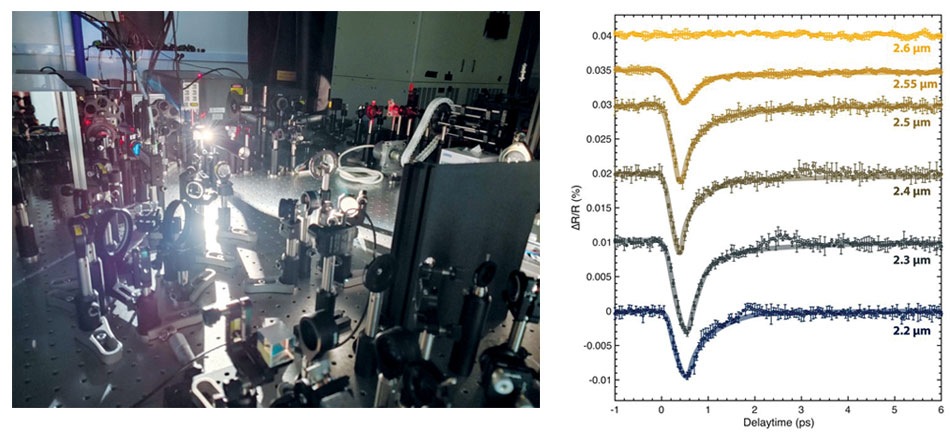
Figure 9. (Left) Our setup for time-resolved optical spectroscopy. (Right) Temporal evolution of the low-energy excitations in Sr2IrO4, showing resonant behaviors upon change of the pump energy.
Ultrafast time-resolved optical spectroscopy measures transient change of reflectivity and its recovery to equilibrium following an excitation of the sample by a pump-beam, and thereby studies the relaxation process and elementary excitations, allowing useful information on the nature of quasiparticles and their interactions. We use optical parametric amplifiers (OPAs) generating femto-second laser pulses over a wide range of wavelengths (from ultraviolet ~330 nm to mid-infrared ~20,000 nm), to induce resonance with excitations in a certain energy range to study the dynamics of various elementary excitations. The below figure shows a representative data showing transient reflectivity measurement on Sr2IrO4. As the pump-beam energy exceeds the band gap (~0.5 eV), a negative change in transient reflectivity induced by electron-hole pairs created and its subsequent recovery can be seen. In addition, a subtle oscillatory pattern, indicative of some sort of elementary excitation, can be seen, whose structure appears to be dependent on the pump beam energy. We are improving the setup to achieve a lower noise level and a higher sensitivity, and with installation of a cryostat in mid 2021, temperature dependency over the 4-350 K can be studied.
고휘도 엑스선 회절 장비는 물질 내 원자핵의 배열에서 오는 격자 구조와 동역학을 밝히는 것에 초점을 두며, 전자의 동역학 연구를 수행하는 공명 비탄성 엑스선 산란 분광기와 스핀-궤도 물질의 연구에서 상보적인 역할을 담당한다. 이러한 연구 목적을 위해 강한 밝기의 엑스선 발생 장치와 높은 해상도의 엑스선 영역 검출기를 결합한 고휘도 엑스선 회절 장비가 구축되었다. 2019년 고휘도 엑스선을 만들어 내기 위해 액체 상태의 타깃에 전자빔을 입사하는 새로운 방식의 엑스선 선원을 국내 최초로 도입하였다. 테스트를 통해 설계치인 80μm의 작은 엑스선 빔 사이즈와 8.7E11 ph/s/mm2의 높은 휘도를 확인하였다. 해당 장비의 안전한 운용을 위하여 납으로 차폐된 별도의 엑스선 실을 조성하였으며 자체적인 안전 연동장치 회로의 구축에도 성공하였다. 샘플을 역격자 공간에서 원하는 위치로 이동시키기 위해 카파 4축 회절기를 사용하고 있다. 자동화된 모터 테이블과 스펙 컨트롤 프로그램을 통해 장비의 자유로운 운용이 가능하다.
2020년에는 고해상도 엑스선 영역 검출기의 도입을 통해 고품질의 데이터를 보다 효율적으로 측정할 수 있게 되었다. 아래 그림과 같이 넓은 역격자 공간에서 회절 패턴을 측정하여 격자 정보를 포함한 다양한 샘플 특성을 알아내는 것이 가능 하다. 현재 기본적 특성 측정 외에도 영역 검출기의 장점을 활용하여 빠른 결정 구조 분석과 열확산신호 격자 동역학 연구가 가능할 수 있도록 소프트웨어를 개발 중이다. 하드웨어 측면에서는 2021년 중순에 질소 가스 냉각 시스템을 갖춰 80K에서 500K까지 넓은 범위에서 샘플의 온도를 변화시킬 수 있도록 하고자 한다. 온도에 따른 결정 구조의 변화나 격자 동역학의 변화와 같은 다양한 상전이 현상을 연구할 수 있게 되어 전체 X-선 회절 장비의 효용이 크게 향상될 것으로 기대한다.
-
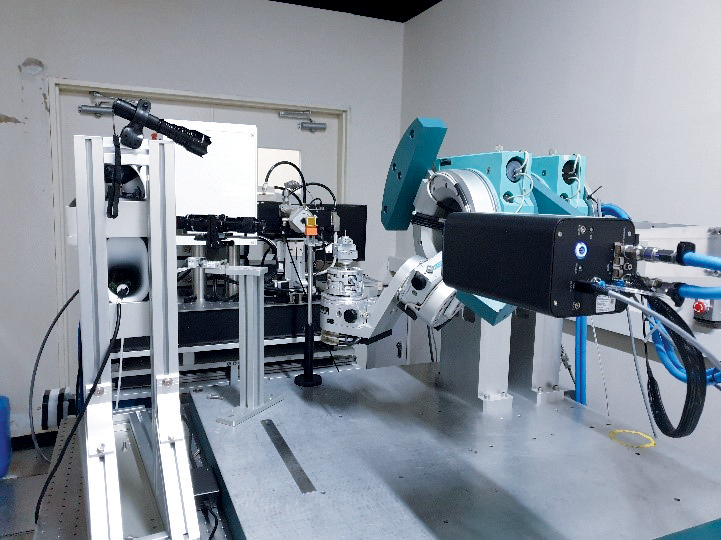
Figure 10. The high-brilliance x-ray diffractometer consisting of a metal-jet source and an area detector
-
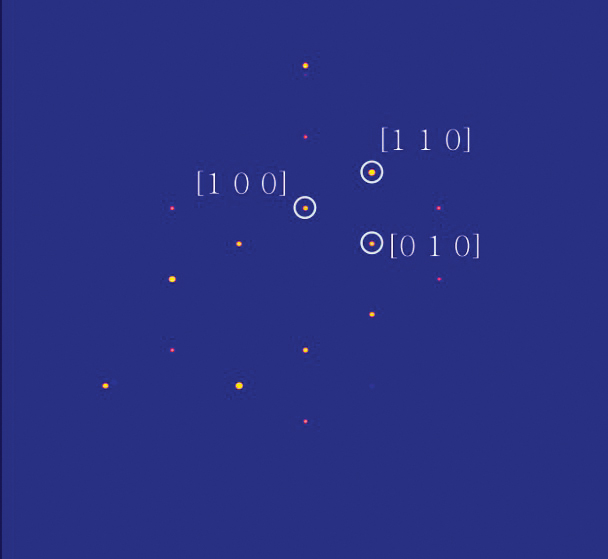
Figure 11. Diffraction pattern from a hexagonal single crystal TiSe2 with a high-resolution area detector
The high-brilliance x-ray diffractometer is focused on the study of the lattice of solids, complementary to the resonance inelastic x-ray scattering spectrometer (RIXS) focused on the electrons. We developed an x-ray diffractometer that combines a high-brightness source and a high-resolution area detector.
In 2019, for the first time in Korea, we introduced a new type of x-ray source that guides high-flux of electron beams to a liquid-state target to produce a high-brilliance x-ray. We confirmed that a small beam size of 80 μm and high luminance of 8.7E11 ph/s/mm2. For the operation safety, we constructed a lead- shielded x-ray room and implemented a safety interlock. A kappa 4-circle diffractometer orients the sample to the desired position in the reciprocal space. The machine can be operated through an automated motor table and control program.
With the introduction of high-resolution area detectors in 2020, it became possible to collect high-quality data more efficiently. We can study sample characteristics including lattice parameters by measuring a diffraction pattern in a large reciprocal space. We are currently working on software development to enable rapid crystal structure analysis and lattice dynamics study that fully exploits the advantages of the area detectors. Hardware-wise, we expect to have a nitrogen cryostream in mid-2021 which controls the sample temperature in a wide range from 80K to 500K. We expect that it will allow us to study various phase transitions increasing the utility of the high-brilliance x-ray diffractometer.
 Center for Artificial Low
Center for Artificial Low